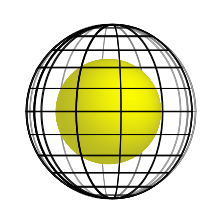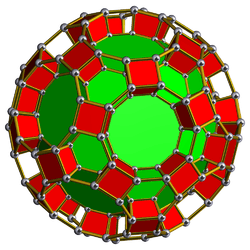Spherinder

In four-dimensional geometry, the spherinder, or spherical cylinder or spherical prism, is a geometric object, defined as the Cartesian product of a 3-ball (or solid 2-sphere), radius r1 and a line segment of radius r2:
Like the duocylinder, it is also analogous to a cylinder in 3-space, which is the Cartesian product of a disk with a line segment.
It can be seen in 3-dimensional space by stereographic projection as two concentric spheres, in a similar way that a tesseract (cubic prism) can be projected as two concentric cubes.
Relation to other shapes
In 3-space, a cylinder can be considered intermediate between a cube and a sphere. In 4-space there are three intermediate forms between the tesseract (1-ball × 1-ball × 1-ball × 1-ball) and the hypersphere (4-ball). They are the:
- cubinder (2-ball × 1-ball × 1-ball), whose surface consists of four cylindrical cells and one square torus.
- spherinder (3-ball × 1-ball), whose surface consists of three cells - two spheres, and the region in between.
- duocylinder (2-ball × 2-ball), whose surface consists of two toroidal cells.
These constructions correspond to the five partitions of 4, the number of dimensions.
If the two ends of a spherinder are connected together, or equivalently if a sphere is dragged around a circle perpendicular to its 3-space, it traces out a spheritorus.
Related 4-polytopes

It is related to the uniform prismatic polychora, which are cartesian product of a regular or semiregular polyhedron and a line segment. There are eighteen convex uniform prisms based on the Platonic and Archimedean solids (tetrahedral prism, truncated tetrahedral prism, cubic prism, cuboctahedral prism, octahedral prism, rhombicuboctahedral prism, truncated cubic prism, truncated octahedral prism, truncated cuboctahedral prism, snub cubic prism, dodecahedral prism, icosidodecahedral prism, icosahedral prism, truncated dodecahedral prism, rhombicosidodecahedral prism, truncated icosahedral prism, truncated icosidodecahedral prism, snub dodecahedral prism), plus an infinite family based on antiprisms, and another infinite family of uniform duoprisms, which are products of two regular polygons.
See also
References
- The Fourth Dimension Simply Explained, Henry P. Manning, Munn & Company, 1910, New York. Available from the University of Virginia library. Also accessible online: The Fourth Dimension Simply Explained—contains a description of duoprisms and duocylinders (double cylinders)
- The Visual Guide To Extra Dimensions: Visualizing The Fourth Dimension, Higher-Dimensional Polytopes, And Curved Hypersurfaces, Chris McMullen, 2008, ISBN 978-1438298924